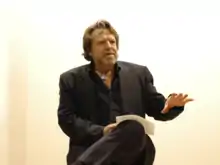A Declaration of the Independence of Cyberspace
"A Declaration of the Independence of Cyberspace" is a widely distributed early paper on the applicability (or lack thereof) of government on the rapidly growing Internet. Commissioned for the pioneering Internet project 24 Hours in Cyberspace, it was written by John Perry Barlow, a founder of the Electronic Frontier Foundation, and published online on February 8, 1996, from Davos, Switzerland.[1] It was written primarily in response to the passing into law of the Telecommunications Act of 1996 in the United States. In 2014, the Department of Records recorded and released audio and video content of Barlow reading the Declaration.[2][3]

Content
Governments of the Industrial World, you weary giants of flesh and steel, I come from Cyberspace, the new home of Mind. On behalf of the future, I ask you of the past to leave us alone. You are not welcome among us. You have no sovereignty where we gather.
— John Perry Barlow, "A Declaration of the Independence of Cyberspace"
The declaration sets out, in sixteen short paragraphs, a rebuttal to government of the Internet by any outside force, specifically the United States. It states that the United States did not have the consent of the governed to apply laws to the Internet, and that the Internet was outside any country's borders. Instead, the Internet was developing its own social contracts to determine how to handle its problems, based on the golden rule. It does this in language evocative of the United States Declaration of Independence and obliquely cites it in its final paragraphs. Although the paper mentions the Telecommunications Act, it also accuses China, Germany, France, Russia, Singapore, and Italy of stifling the Internet.[4]
Background
At the time the paper was written, Barlow had already written extensively on the Internet and its social and legal phenomena,[5] as well as being a founding member of the Electronic Frontier Foundation.[6] The work he was known best for previously, "The Economy of Ideas", published March 1994 in Wired magazine, also made allusions to Thomas Jefferson and some of the ideas he would write about in his declaration.
Critical response
Because of its subject matter, Barlow's work quickly became famous and widely distributed on the Internet. Within three months, an estimated 5,000 websites had copies of the declaration.[7] At nine months, that number was estimated to be 40,000.[8] To approach Barlow's vision of a self-governing Internet, a virtual magistrate was set up by the Cyberspace Law Institute, now hosted by the Chicago-Kent College of Law. Magistrates would be appointed by the institute and other legal groups to solve online disputes.[7] The declaration has been criticized for internal inconsistencies.[9] The declaration's assertion that 'cyberspace' is a place removed from the physical world has also been challenged by people who point to the fact that the internet is always linked to its underlying geography.[10]
Outside the Internet, the response was less positive. Larry Irving, the Assistant Secretary of Commerce, said that a lack of safeguards would "slow down the growth of what is likely to be a major boon for consumers and business".[7] In the online magazine HotWired, one columnist referred to his document as simply "hogwash".[11]
By 2002 the number of sites copying the declaration was estimated to have dropped to 20,000.[12] In 2004, Barlow reflected on his 1990s work, specifically regarding his optimism. His response was that "we all get older and smarter".[13]
See also
References
- "John Perry Barlow: Is Cyberspace Still Anti-Sovereign?". 12 February 2018.
- "Department of Records". www.departmentofrecords.co. Archived from the original on 2017-07-04. Retrieved 2015-03-08.
- "Limited edition vinyl: John Perry Barlow reads "A Declaration of the Independence of Cyberspace" / Boing Boing". boingboing.net.
- Barlow, John Perry (1996-02-08). "A Declaration of the Independence of Cyberspace". Retrieved 2017-02-23.
- Ley, Michael. "DBLP: John Perry Barlow". Archived from the original on 25 February 2007. Retrieved 2007-02-09.
- "EFF: Board of Directors". Archived from the original on 6 February 2007. Retrieved 2007-02-09.
- Yang, Catherine (1996-05-06). "Law Creeps Onto the Lawless Net". BusinessWeek (3474): 58–64. Retrieved 2007-02-08.
- Frezza, Bill (1996-11-01). "Can Public Network Computing Save Democracy". Network Computing: 35.
- Evans, Woody (2016). "Cyberspace is the Child of the Industrial Age - Defining it as Independent is Nonsense". Institute for Ethics and Emerging Technologies.
- Graham, Mark (2013-03-01). "Geography/internet: ethereal alternate dimensions of cyberspace or grounded augmented realities?". The Geographical Journal. 179 (2): 177–182. doi:10.1111/geoj.12009. ISSN 0016-7398.
- Cembalest, Robin (1996-09-20). "The Featherman File". Forward. C: 2.
- Barlow, John Perry (22 January 2002). "John Perry Barlow Declaration for Defendants in MGM et al. v. Grokster et al". Archived from the original on 10 February 2007. Retrieved 9 February 2007.
- Doherty, Brian (August–September 2004). "John Perry Barlow 2.0: The Thomas Jefferson of cyberspace reinvents his body — and his politics". Reason. Archived from the original on September 3, 2009.
External links
| Wikisource has original text related to this article: |
| Wikiversity has learning resources about A Declaration of the Independence of Cyberspace |
- A Declaration of the Independence of Cyberspace
- A Declaration of the Independence of Cyberspace (Audio Recording)
- A Declaration of the Independence of Cyberspace (Portuguese Translation in PDF)
- A Declaration of the Independence of Cyberspace (Spanish Translation)
- A Declaration of the Independence of Cyberspace (official vinyl release with accompanying video and audio recordings read by John Perry Barlow and scored by Drazen Bosnjak)
- Another Declaration Of Independence For Cyberspace which was conceived simultaneously and independently from the Barlow version. Note: archive.org time stamp is later than original publish date which happened during HotWired/Weiner's Blue Ribbon Campaign where it hung and was blocked in the listserv for 1 hour when Barlow's version was delivered to the listserv using the same Subject line as this version from Citizens Of The Sea.